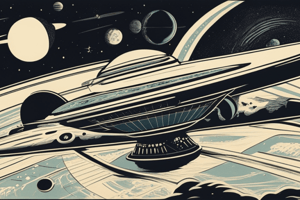Podcast
Questions and Answers
Which planet is known for its large red spot?
Which planet is known for its large red spot?
- Neptune
- Saturn
- Jupiter (correct)
- Mars
What is the difference between a meteor and a meteorite?
What is the difference between a meteor and a meteorite?
- A meteor is a rock in space, while a meteorite is a rock that has fallen to Earth.
- A meteor is a rock that burns up in the atmosphere, while a meteorite is a rock that survives and hits Earth. (correct)
- A meteor is a rock that has fallen to Earth, while a meteorite is a rock in space.
- There is no difference between the two.
What is the correct order of the following objects from smallest to largest?
What is the correct order of the following objects from smallest to largest?
- Comet, Moon, Earth, Sun (correct)
- Earth, Moon, Comet, Sun
- Moon, Earth, Sun, Comet
- Comet, Earth, Moon, Sun
What is the difference between a solar eclipse and a lunar eclipse?
What is the difference between a solar eclipse and a lunar eclipse?
What does the term 'umbra' refer to in relation to eclipses?
What does the term 'umbra' refer to in relation to eclipses?
Flashcards
Light year
Light year
The distance light travels in one year.
Solar eclipse
Solar eclipse
Occurs when the moon perfectly aligns between Earth and the sun.
Lunar eclipse
Lunar eclipse
When Earth's shadow falls on the moon, often turning it red.
Gravitational field strength
Gravitational field strength
Signup and view all the flashcards
Asteroid belt
Asteroid belt
Signup and view all the flashcards
Study Notes
Space Revision
- A light year is the distance light travels in a year
- The moon is a natural satellite that orbits Earth
- A planet is a circular object orbiting a star (like the sun)
- Mercury is the smallest and closest planet to the sun
- Venus is the hottest planet
- Earth is the only known place with water and life
- Mars is known as the red planet
- Jupiter is the largest planet and has a large red spot
- Saturn has rings and approximately 150 moons
- Uranus is a tilted planet
- Neptune has rains of diamonds
- Pluto is not a planet, but a dwarf planet located in the Kuiper belt
Comets, Meteors, and Meteorites
- Comets are dust particles frozen in ice that orbit the sun
- Meteors are dust and rock moving through the sky
- Meteorites are any type of meteor that has fallen on Earth
- Asteroid belts are a belt full of rock and stone and sit between Mars and Jupiter
- A solar system is a system that has a star and planets
Solar Eclipse
- A solar eclipse occurs when the moon passes between the sun and Earth
- The moon casts a shadow on Earth during a solar eclipse
- The umbra is the darkest part of the shadow
- The penumbra is the outer part of the shadow
- A solar eclipse will only be noticeable if the sun, Earth, and moon are perfectly aligned
Lunar Eclipse
- A lunar eclipse occurs when Earth passes between the sun and the moon
- Earth casts a shadow on the moon during a lunar eclipse
- There are two types of lunar eclipses: partial and total
- Partial lunar eclipses occur when only part of the moon enters Earth's umbra
- Total lunar eclipses happen when the entire moon enters Earth's umbra, causing the moon to appear reddish (blood moon)
Diagram of Sun, Earth, Moon, and Comet
- Diagrams illustrating the relative positions of the Sun, Earth, Moon, and a comet
Calculating Gravitational Field Strength
- A method for calculating gravitational field strength, mass, and weight using a triangle
- Steps for finding unknown values (mass, G, W) involve multiplication and division using the correct units. Weight (W) should be used first when dividing.
Studying That Suits You
Use AI to generate personalized quizzes and flashcards to suit your learning preferences.




